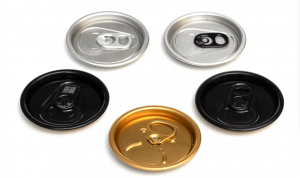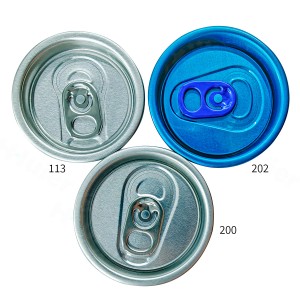As is well known, two-piece aluminum cans have many advantages, such as light weight and easy portability; Not easily broken, good safety; The advantages of excellent sealing and long shelf life of the contents have earned two aluminum cans the position of the best beverage packaging can in the minds of consumers in the United States and Europe, and the demand has remained high for a long time. In contrast, the demand space for aluminum easy open end in the market is also very large.
Generally speaking, beverage can easy open lids are divided into pull tab lids (RPT) and eco-friendly can lids (SOT). The beverage type easy to pull lid has excellent barrier properties. Not only can it block gas, but it can also block light, which can make beverages have a longer shelf life. For easy open can lids with the same thickness, the scratch allowance of environmentally friendly lids is generally smaller than that of pull tab lids, which is specially designed according to the opening mechanism requirements.

However, both from the perspective of the product itself and the production process, the production difficulty of easy open aluminum lid is relatively high. On the one hand, from the perspective of the product itself, aluminum easy open end are difficult to grow due to the thin and delicate aluminum material, as well as significant deformation during the manufacturing process. On the other hand, from the perspective of production technology, the production of easy open pull ring aluminum lids in China is a high-speed automated large-scale production, and the technology for making can lids is purely imported. It is still in the process of reference and application, and continuous accumulation of experience is needed to seek progress.
The following are common problems and solutions for aluminum easy to pull ring aluminum lid in production
1、 At present, the production of easy open lids is controlled by distinguishing the scratch allowance of these two different opening forms of easy to pull lids, and determining the specific value based on the machine situation and aluminum thickness. If the scratch allowance of the environmental protection cover increases to the control range of the pull tab cover, it may cause the inability to open normally. Similarly, if the notch margin of the pull tab cover is reduced to the control range of the environmentally friendly cover, the soda can beverage product is more prone to tongue flying problems.
Easy open lid is a type of can lid with a scratch on the opening part and equipped with a pull tab for easy opening. According to different opening methods, it can be divided into hole opening tear off type easy pull cover (RPT), hole opening lifting and pressing retention type easy open lid (SOT), and fully open easy pull cover. Opening force is an important aspect of quality control for easy to open lids, in order to ensure that canned foods are easy to open and that the marks are not easily damaged during storage and transportation. The country has strict requirements for the opening force of easy to pull lids: RPT type opening force 9-15N (GB/T17950-1998). Aluminum materials that are easy to open can affect the opening force.
1. The opening force of easy to pull lids produced from different alloy aluminum materials varies. The material for easy to pull lids is generally selected from alloy aluminum materials such as 5052 and 5182, which have excellent can opening performance. The 5182 type, which contains 4% -5% magnesium and 0.35% manganese, is a suitable hard material with high compressive strength (630kpa) for manufacturing beer or carbonated beverages. 5052 soft material is commonly used for can lids with low internal pressure resistance (310kpa) such as juice and tea. Experimental results have shown that the opening force of the can lid produced from 5182 material is about 1-2N greater than that produced from 5052 material.
2. The opening force of easy open end produced by different aluminum manufacturers varies. To ensure the quality of easy open lids, currently domestic aluminum can lid materials mainly rely on imports. The production process and alloy distribution of each aluminum manufacturer vary, which also has a certain impact on the opening force of the easy to pull lid.
3. The pattern of aluminum affects the opening force. Aluminum is formed by secondary cold rolling, and its forming pattern can be clearly observed under a microscope. Experimental results have shown that the opening force of an aluminum lid with the same direction as the opening direction of the pull tab is 0.3-0.5N greater than that of a lid with a horizontal pattern.
4. The storage time of aluminum affects the opening force. Magnesium aluminum alloy exhibits softening during storage at room temperature.
Therefore, the storage period of aluminum and easy to pull covers also has a certain impact on the opening force. In response to the impact of aluminum opening force, it is necessary to strengthen the inspection, batch differentiation, inventory management of incoming materials from suppliers, and make appropriate modifications to the processing technology and enterprise standards according to different profiles in compliance with national standards.
II. In high-temperature and high-humidity environments during summer, high-carbonated cans often experience cracking at the notch where the lid can be easily opened, a phenomenon known as stress corrosion. Stress corrosion is a phenomenon where notch cracking occurs due to the simultaneous occurrence of tensile stress and corrosive environment at the notch of aluminum cans, sometimes even causing discoloration of the pull tab.
The sensitivity, tensile stress resistance, and corrosive environment of the easy-open end (EOE) material are three fundamental factors contributing to stress corrosion. EOE, which is made of aluminum alloy, is a sensitive material. High-carbonated beverages in aluminum cans exhibit high internal pressure, and the score margin of the EOE is smaller than the thickness of the lid, making it the strongest point in terms of tensile stress resistance. During the filling process, the residual beverage liquid on the surface of the canned beverage and the lubricating fluid on the conveyor belt contain chlorides and sulfates, which, combined with the residual moisture on the surface of the canned beverage lid, create a corrosive environment.
The residual moisture within the score, high storage temperature, and humid storage environment are the three factors that contribute to the cracking of the easy-open lid score. The small amount of residual moisture, chloride, and sulfate within the score will accelerate the corrosion of the score surface. Higher storage temperature will lead to accelerated formation of corrosion mechanisms and corresponding increase in stress. A humid storage environment will slow down the evaporation of moisture, resulting in the formation of a specific “greenhouse” within the shrink film packaging.
If the residual thickness increases while the residual moisture remains, the stress corrosion medium remains unchanged, and the time for cracking to occur due to scratching will only be slightly extended.
Post time: Apr-16-2025







